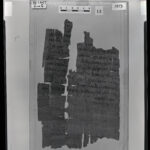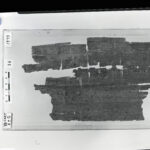| Artefact ID | 307 |
| TM ID | TM 32409 |
| Findspot (DEChriM ID) | 34 (Ǧabal al-Ṭārif) | Class | Textual |
| Material | Papyrus |
| Writing medium | Sheet/roll |
| Text content | Documentary |
| Language | Greek |
| Description | P.Nag Hamm. 67: mutilated letter. Although neither sender nor receiver are identified, the letter is addressed on the back "to my beloved brother". It concerns a request to have a small quantity of grain transported by boat and stored in a monk's dwelling (μονάχιον). In the end greetings, the writer speaks of "the brothers who are with you and those with me". The editor suggests: "it seems natural to suppose that two groups of monks, or at least religious fellowships of some sort, are meant" (see ed. pr.: Barns et al 1981: 8). Recto: written along the fibres. Verso: address, along the fibres. This letter is one of many from the cartonnage of Codex VII that show contact with a monastic milieu and might belong to the archive of the monk Sansnos, see Choat in Choat and Giarda 2017: 35-36. |
| Selection criteria | Mention of Christian cult officials/institutions, Christian terms/formulas/concepts |
| Date from | 325 |
| Date to | 375 |
| Dating criteria | Palaeography. Also, other waste papyri recovered from the same cartonnage used to construct the Nag Hammadi codex VII include contracts dated 341, 346 and 348 (PNH 65). |
| Absolute/relative date | Relative date |
| Archaeological context | The leather covers of eight of the twelve Nag Hammadi codices, which were found in a sealed jar by Egyptian agricultural workers in 1945 (see ID 23), had been strengthened by cartonnage made of waste papyri. This papyrus comes from the richest of these cartonnages (codex VII). |
| Accession number | Cairo, Coptic Museum Nag Hamm. VII 7 c |


 Json data
Json data





